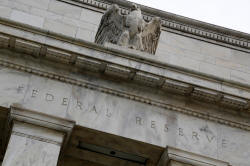How excess cash is playing out in U.S. reverse repo and money markets
 Send a link to a friend
Send a link to a friend
 [July 05, 2021] By
Gertrude Chavez-Dreyfuss [July 05, 2021] By
Gertrude Chavez-Dreyfuss
NEW YORK (Reuters) -The U.S. debt ceiling
comes back into effect at the end of July, putting pressure on the
Treasury to reduce its cash balance ahead of the deadline. That means
more injections of cash into a financial system already swimming with
liquidity, potentially sinking short-term rates and causing undue
distortion in money markets.
On Wednesday, nearly a trillion dollars in cash, a record high, gushed
into the Federal Reserve's reverse repo (RRP) facility.
On Thursday and Friday, reverse repo volumes came off their highs to
$742.6 billion and $731.5 billion, respectively.
The record volume came after the Fed last month made a technical
adjustment to the interest rates it manages, raising the rate paid banks
on excess reserves (IOER) held at the Fed to 0.15% from 0.10% and
lifting the rate paid on reverse repos to 0.05% from zero.

WHAT IS THE FED'S REVERSE REPO WINDOW?
The Fed launched its reverse repo program (RRP) in 2013 to mop up extra
cash in the repo market and create a strict floor under its policy rate,
or the effective fed funds rate, currently in a target range of
0%-0.25%. Eligible counterparties lend cash to the Fed in return for
Treasury collateral on an overnight basis.
WHAT IS THE CONNECTION BETWEEN THE SURGE IN CASH AND THE DEBT CEILING?
The market is confronted with a surfeit of cash in the banking system
due to Fed asset purchases as part of quantitative easing and as a
result of the U.S. Treasury's financial support to the economy in
response to the pandemic.
The U.S. Treasury needs to run down its cash balance in the Treasury
General Account (TGA) deposited at the Fed to a $450 billion target
before a two-year debt ceiling suspension expires on July 31. As of June
29, the Treasury has a cash balance of $711 billion, Wrightson ICAP data
showed.
[to top of second column] |

An eagle tops the U.S. Federal Reserve building's facade in
Washington, July 31, 2013. REUTERS/Jonathan Ernst/File Photo

A TGA reduction increases reserves in the banking system, which have now flowed
into the RRP market.
ARE SURGING REVERSE REPO VOLUMES A CONCERN?
The rate increase in the RRP could reduce money market funds' demand for U.S.
Treasury bills because the latter's rates are pinned at lows. For instance,
rates on U.S. 3-month T-bills are currently hovering below 0.05%.
Zoltan Pozsar, global head of short-term interest rate strategy at Credit
Suisse, said the rotation from bills to RRPs won't happen quickly as bills are
currently underwater, which means they can only be sold at a loss.
"But happen it will," he said.
Investors are also monitoring whether the amount of reserves and deposits that
banks may lose to the RRP facility could be large enough to disrupt interest
rate market dynamics.
Lou Crandall, Wrightson chief economist, believes bank outflows are not a
problem just yet.
If banks are concerned they might see excessive outflows because money market
funds can earn 0.05% at the RRP facility, they can match that rate to retain
their deposits, he said.
(Reporting by Gertrude Chavez-Dreyfuss; Editing by Alden Bentley and Andrea
Ricci)

[© 2021 Thomson Reuters. All rights
reserved.] Copyright 2021 Reuters. All rights reserved. This material may not be published,
broadcast, rewritten or redistributed.
Thompson Reuters is solely responsible for this content. |